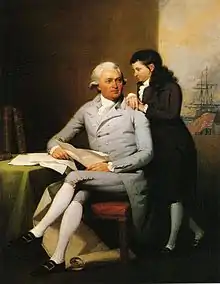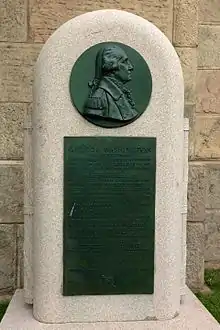Jeremiah Wadsworth
Jeremiah Wadsworth (July 12, 1743 – April 30, 1804) was an American sea captain, merchant, and statesman from Hartford, Connecticut who profited from his position as a government official charged with supplying the Continental Army. He represented Connecticut in both the Continental Congress and the United States House of Representatives.
Jeremiah Wadsworth | |
|---|---|
 | |
| Member of the U.S. House of Representatives from Connecticut's At-large district | |
| In office March 4, 1789 – 1795 | |
| Preceded by | Position established |
| Personal details | |
| Born | July 12, 1743 Hartford, Connecticut Colony, British America |
| Died | April 30, 1804 (aged 60) Hartford, Connecticut, U.S. |
| Citizenship | |
Early life
He was a descendant of William Wadsworth, one of the founders of Hartford and a pastor of the town's Center Congregational Church. He went to sea in 1761 at the age of 18 for health reasons, starting as a regular sailor on one of his uncle's ships. He rose to become first mate of a vessel and eventually a captain who made his fortune in the West India trade.[1]
During the American Revolution

When the war started, Wadsworth was appointed to a committee charged with buying 5,000 pairs of yarn stockings for the army (which had already been sent to Canada). He served on another committee to procure 1,800 pounds of "lawful money in specie" in exchange for bills for use by the army. The Connecticut General Assembly later commissioned him and Col. Jonathan Fitch to find a large number of tin kettles for the army. The next assignment was to buy up as much pork as he could (both to furnish the American army and to keep it out of the hands and stomachs of the British forces).[1]
Having served effectively in these assignments in Connecticut, Congress elected him Deputy Commissary General of Purchases on June 17, 1777, but he resigned in August. When Congress reorganized the supply system, he became Commissary General in April 1778, resigning in December 1779.[1]
Reaching the rank of colonel, he became commissary for Comte de Rochambeau's army until the war's end. In the summer of 1783, he went to Paris to report to the French on his activities.[1]
He is said to have turned a good profit for himself in his transactions for supplies.[1]
Wadsworth was a good friend of Nathanael Greene and during the time Greene was Quarter-master General they formed some investment partnerships.
After the Revolution
Wadsworth became a "pioneer in banking, insurance, and the breeding of cattle" after the war, according to historian North Callahan.[1]
He was a member of the Continental Congress in 1788 and a member of the Connecticut convention which ratified the U.S. Constitution in 1788. From 1789 to 1795 he served three terms in the U.S. House of Representatives. He was a member of the Connecticut House of Representatives in 1795 and of the state Executive Council from 1795 to 1801.[2]
He was appointed Treaty Commissioner, by George Washington, at the Treaty of Big Tree between the U.S. and the Seneca nation in 1797.
He died in Hartford, Connecticut, April 30, 1804, and is interred in the Ancient Burying Ground.[2] His domestic arrangements were described by Lydia Sigourney in her memoirs.[3] He built two mansions near his own house, one for his daughter, who had married Nathaniel Terry, and one for his son, Daniel Wadsworth.[4]
Legacy
In World War II, the United States liberty ship SS Jeremiah Wadsworth was named in his honor.
Footnotes
- Callahan, North, Connecticut's Revolutionary War Leaders A publication of the American Bicentennial Commission of Connecticut (Pequot Press: Chester, Connecticut), 1973, chapter on Jeremiah Wadsworth pp. 36-37
- "WADSWORTH, Jeremiah, (1743 - 1804)" Web page at the Web site of the "Biographical Directory of the United States Congress," accessed August 6, 2006
- Sigourney, Lydia (1866). Letters of Life. Retrieved July 19, 2017.
- Sigourney, Lydia (1866). Letters of Life. Retrieved July 19, 2017.
External links
- United States Congress. "Jeremiah Wadsworth (id: W000013)". Biographical Directory of the United States Congress.
- "Colonel Jeremiah Wadsworth". Connecticut Sons of the American Revolution.
| U.S. House of Representatives | ||
|---|---|---|
| Preceded by District created |
Member of the U.S. House of Representatives from Connecticut's at-large congressional district March 4, 1789 – March 3, 1795 |
Succeeded by Nathaniel Smith |